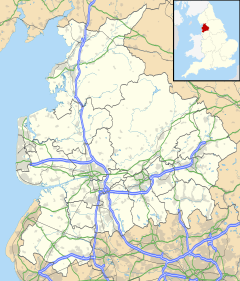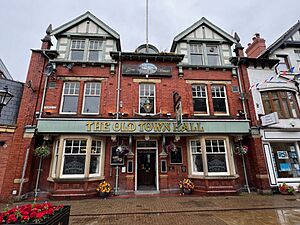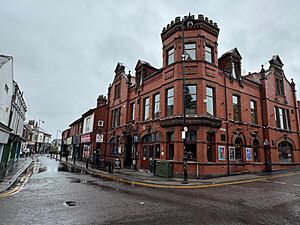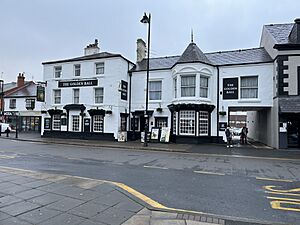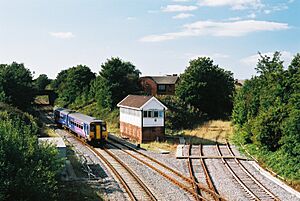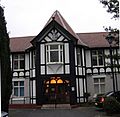Poulton-le-Fylde facts for kids
Quick facts for kids Poulton-le-Fylde |
|
|---|---|
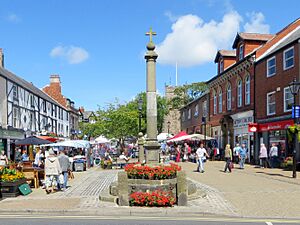 Poulton-le-Fylde's Market Place |
|
| Population | 18,115 (2021 Census) |
| OS grid reference | SD3439 |
| District |
|
| Shire county | |
| Region | |
| Country | England |
| Sovereign state | United Kingdom |
| Post town | POULTON-LE-FYLDE |
| Postcode district | FY6 |
| Dialling code | 01253 |
| Police | Lancashire |
| Fire | Lancashire |
| Ambulance | North West |
| EU Parliament | North West England |
| UK Parliament |
|
Poulton-le-Fylde (often called Poulton) is a historic market town in Lancashire, England. It is located on a flat coastal area known as the Fylde. In 2021, about 18,115 people lived there.
People have lived in this area for a very long time, possibly as far back as 12,000 years ago. Roman artifacts have also been found here. After the Normans arrived in 1066, Poulton was a small farming village. Its church, St Chad's, was first mentioned in 1094.
Later, Poulton grew into an important trading hub. It had busy weekly markets and two small harbours on the River Wyre. Goods were bought and sold, coming from and going to places far away. In 1837, it was even called the "metropolis of the Fylde" because of its importance. However, its role as a major trading centre became less important in the mid-1800s. This happened as nearby coastal towns like Fleetwood and Blackpool grew bigger.
Today, Poulton is the administrative centre for the Borough of Wyre. It is also part of the larger Blackpool Urban Area, about 5 miles (8 km) from Blackpool's town centre. The town has train connections to Blackpool and Preston, and bus routes to other towns and villages in the Fylde. Poulton has a library and two secondary schools: Baines School and Hodgson Academy. You can also find a farmers' market once a month and a weekly market every Monday.
Contents
History of Poulton-le-Fylde
Early Times and Roman Finds
People have lived in the Poulton area for a very long time, possibly since around 10,000 BC. In 1970, workers in nearby Carleton found the 12,000-year-old bones of an elk. Close to the bones were two sharp bone or antler tools.
When the Romans arrived in the 1st century AD, a Celtic tribe called the Setantii lived here. Later, a large collection of 400 Roman coins from the 4th century was found near Fleetwood. Other Roman items, like a medal and a special horseshoe-like object called a hipposandal, have also been found in Poulton and Skippool.
From Anglo-Saxons to Normans
Even though there isn't much archaeological proof, local place names suggest that Anglo-Saxon settlements were founded here. Words like tūn (meaning "farmstead") are part of names like Thornton and Marton. Poulton itself was called Poltun in 1086. This name comes from old English words meaning "farmstead by a pool or creek." The name le-Fylde was added in 1842 to help tell it apart from another Poulton.
Before the Normans took over in 1066, the area belonged to Earl Tostig. After the Normans won, King William the Conqueror gave the land to Roger the Poitevin. The Domesday Book of 1086 mentioned three churches in the area, and one was likely Poulton's church. In 1094, Roger gave the church and some land to a priory (a type of monastery) in Lancaster. Later, the church was given to the Abbey of Syon in Middlesex in 1415.
Poulton During the Civil War
During the English Civil War in the 1600s, people from Poulton fought on both sides, though more supported the King. No big battles happened right in Poulton, but the area suffered from the poverty caused by the wars. In 1643, a large Spanish ship appeared off the coast. Locals first feared an invasion, but then realized the crew was sick and needed help. The ship was carrying supplies for the Parliamentarian forces. Royalists brought the ship into the River Wyre and burned it, setting the Spanish crew free.
In the 1700s, Poulton's port was involved in some trading voyages.
In 1732, a fire destroyed many thatched-roof cottages on the west side of Market Place. Sparks from funeral torches, carried during a night burial procession, caused the fire. The houses were later rebuilt with brick and tile roofs.
Growth and Change in the 1800s
Poulton became a very important trading hub. With harbours at Skippool and Wardleys on the River Wyre, it could import goods from places like Russia and North America. For example, flax came from Ireland and the Baltic, and timber from across the Atlantic. Records show Poulton imported limestone and oats, and exported cheese. The town held markets for cattle and cloth, and corn fairs every Monday. The market cross likely dates from the 1600s.
The linen industry was big in the Fylde during the 1700s, and Poulton's import of flax was key. However, in the 1800s, craft industries in Poulton declined. This was due to new machines and a lack of interest in new industrial methods among local leaders.
Poulton's importance changed with the growth of nearby coastal towns. In 1836, the new town of Fleetwood was built 7 miles (11 km) north. Fleetwood was planned as a major port with a railway link to Preston. The railway line, which included a stop in Poulton, was finished in 1840. Fleetwood quickly became the main port. Poulton benefited at first, as Irish and Scottish cattle were brought through Fleetwood for Poulton's market.
Blackpool also grew as a holiday resort. For a few years, visitors would travel by train to Poulton, then take horse-drawn carriages to Blackpool. A train line directly to Blackpool was finished in 1846. As Fleetwood and Blackpool grew, Poulton's importance as a commercial centre slowly faded.
Mains electricity came to Poulton-le-Fylde around 1928.
How Poulton is Governed
Historically, Poulton-le-Fylde was one of seven old parishes in the Amounderness area of Lancashire. It included smaller townships like Carleton and Thornton. Poulton was managed by a local council until 1900, when it became an Urban District. The council was based at the old town hall.
Today, Poulton is part of the Borough of Wyre. This borough was formed in 1974 by combining several smaller districts. Poulton is home to the borough council's main offices, located at the Poulton Civic Centre.
The town has a two-level council system. It's part of both Lancashire County Council and Wyre Borough Council. These councils have different jobs for the area. For example, Wyre Borough Council handles local services. Poulton is divided into four areas (wards), and each elects two councillors to the Wyre Borough Council.
Poulton is also part of the Wyre and Preston North area for the UK Parliament. This area elects one Member of Parliament (MP) to the House of Commons. Since 2010, the MP for this area has been Ben Wallace from the Conservative Party.
Geography and Climate
Poulton-le-Fylde is about 240 miles (386 km) northwest of London. It sits about 19 feet (5.8 metres) above sea level. The town is roughly 5 miles (8 km) northeast of Blackpool and 16.5 miles (26.6 km) northwest of Preston. It is located on the Fylde, a flat coastal area that is like a 13-mile (21 km) square peninsula.
The town is on slightly raised ground, about 1 mile (1.6 km) from the River Wyre and 3 miles (4.8 km) from the Irish Sea. For a long time, Poulton was just a few streets around its central market place. After the Second World War, many new houses were built around it. The Poulton urban area is next to Carleton and Hardhorn, and close to the larger Blackpool Urban Area. The land to the east of the town is mostly used for farming.
Poulton has a generally mild maritime climate, similar to much of the British Isles. This means it has cool summers and mild winters. The area gets about 871.3 mm of rain each year.
Community Life
In 2004, a study looked at Poulton's strengths and weaknesses. It found that the town didn't have cinemas, theatres, museums, or art galleries. People wanted a cinema, a weekly market, and more unique shops. There was also a concern that there weren't enough activities for young people. Poulton does have a library, run by Lancashire County Council.
Poulton has several public green spaces. These include the Jean Stansfield Memorial Park, Tithebarn Park, and the Cottam Hall Playing Fields. Tithebarn Park has grassy play areas. The Cottam Hall Playing Fields have sports pitches and allotments (small plots of land for gardening). There is also a cricket ground. Part of the Wyre Way footpath goes through Poulton.
The Poulton Gala is a fun event held every June. A farmers' market takes place on the fourth Saturday of each month. Since October 2011, a weekly market has been held in the town centre every Monday.
Sports in Poulton
Poulton F.C.
Poulton F.C. is a football club based at Cottam Hall. As of August 2020, they play in the West Lancashire Football League Premier Division. The club started in 1947 as Poulton Athletic. In 1961, Poulton Athletic and Poulton United joined together to form Poulton Town F.C. In 2013, they changed their name to Poulton F.C.
Fylde Cricket Club
Fylde Cricket Club is one of the oldest cricket clubs in Lancashire, started in the early 1800s. Their home ground, known as "The G," is on Moorland Road. The club joined the league in 1922 and has won several cups over the years. They have a first team, a second team, and a Sunday development team.
Wyre Cricket Club
Wyre Cricket Club was formed in 1994. After moving locations a few times, the club settled at Cottam Hall in 2006. They joined the Palace Shield Cricket League in 2014 and quickly earned two promotions. The club also has a second team and a mid-week T20 team.
Famous Landmarks
Poulton town centre has been a special "Conservation Area" since 1979. This means its historic character is protected. Fifteen buildings and structures in the town are "listed buildings," recognized for their special history or architecture. These include churches, market structures, and old houses.
The market place is in the middle of Poulton and is now closed to cars. It is south of St Chad's Church and surrounded by shops. In the square, you can find the town's war memorial, a market cross, stocks (used for punishment), a whipping post, and fish slabs (where fish were sold). Many buildings around the market place were rebuilt after the 1700s fire, but some older ones remain.
Poulton had many pubs and inns because it was a market town. The Golden Ball is an important old inn, probably from the 1700s. It was also where the local court met. The Thatched House pub is another old building, rebuilt in 1910 in a Mock Tudor style. It's considered a "key landmark." The Ship Inn, built in the Edwardian style with red brick and ship carvings, was once a lively pub. From 1928 to 2001, it was a Conservative club. Since 2000, it has been a café, wine bar, and nightclub called the Cube.
Places of Worship
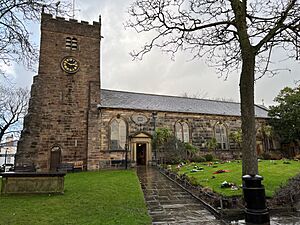
St Chad's Church is the main Anglican church in Poulton. It is in the town centre next to the market place. Most of the church was built in the mid-1700s, but its tower is from the 1600s. It is made of stone with a slate roof. A round, Norman-style section was added in 1868. The churchyard is famous for its beautiful crocuses in spring.
After the English Reformation, many people in the area remained Roman Catholic. In the early 1800s, a Roman Catholic chapel was built in Poulton. This was replaced by a larger church, St John the Evangelist's, built in 1912. It is made of red sandstone in a Romanesque style.
The first Nonconformist group in Poulton was the Methodists, who started meeting in 1784. They built their first chapel in 1819. This chapel was later replaced by a new one in Queen Street in 1970. The Congregational church also built a chapel in town in 1809, which was replaced by a new one in 1899.
In the 2001 census, most people in Wyre (83.06%) said they were Christian. Smaller numbers of people followed other religions or had no religion.
Getting Around Poulton
The railway came to the Fylde in the 1800s because of the growth of Fleetwood. The Preston & Wyre Railway line, connecting Fleetwood to Preston, was finished in 1840. Poulton-le-Fylde railway station was originally located at the bottom of the Breck road. A branch line connecting Poulton to Blackpool opened in 1846.
In 1893, a train derailed at a sharp bend near the station, killing three people. Because of this, a new station was built in 1896 at the top of the Breck. Today, Poulton is a stop on the Caldervale Line and the Blackpool Branch Line. You can catch trains towards Preston and Blackpool North. The line to Fleetwood closed to passengers in 1970, but there have been talks about reopening it.
Poulton is about 13 miles (21 km) west of the M6 motorway and is connected to it by the M55. There are also major roads (A roads) leading to Fleetwood, Blackpool, Preston, and other towns. Several bus companies serve the town, connecting it to coastal towns, nearby villages, and Preston.
Poulton was previously served by Blackpool Airport, but it no longer has commercial flights. Larger airports like Liverpool John Lennon Airport and Manchester Airport are now used.
Schools in Poulton
Poulton has two secondary schools. The oldest, Baines School, was founded in 1717 by James Baines, who left money in his will to create three free schools in the area. Baines School is now a comprehensive secondary school for students aged 11–18. In 2007, it was rated "good" by Ofsted.
Hodgson Academy (formerly Hodgson School) is another comprehensive secondary school. It opened in 1932 and teaches students aged 11–16. In 2008, Ofsted rated it as "outstanding." The school became an academy in 2011.
There are also four primary schools in Poulton: Breck Primary School, St John's Catholic Primary School, Carr Head Primary School, and St Chad's Church of England Primary School. All of these schools have received "good" or "outstanding" ratings in past inspections.
Public Services
United Utilities provides Poulton's water and sewerage. Electricity North West handles the electricity supply. The police force for the area is Lancashire Constabulary. The police station in Poulton closed in January 2018.
NHS services are provided by NHS North West. Local healthcare is managed by the NHS North Lancashire Primary Care Trust. In 2004, there were 11 general doctor's offices in Poulton. More serious medical cases are handled at Victoria Hospital in Blackpool. The North West Ambulance Service provides emergency transport for patients.
Images for kids
See also
 In Spanish: Poulton-le-Fylde para niños
In Spanish: Poulton-le-Fylde para niños


